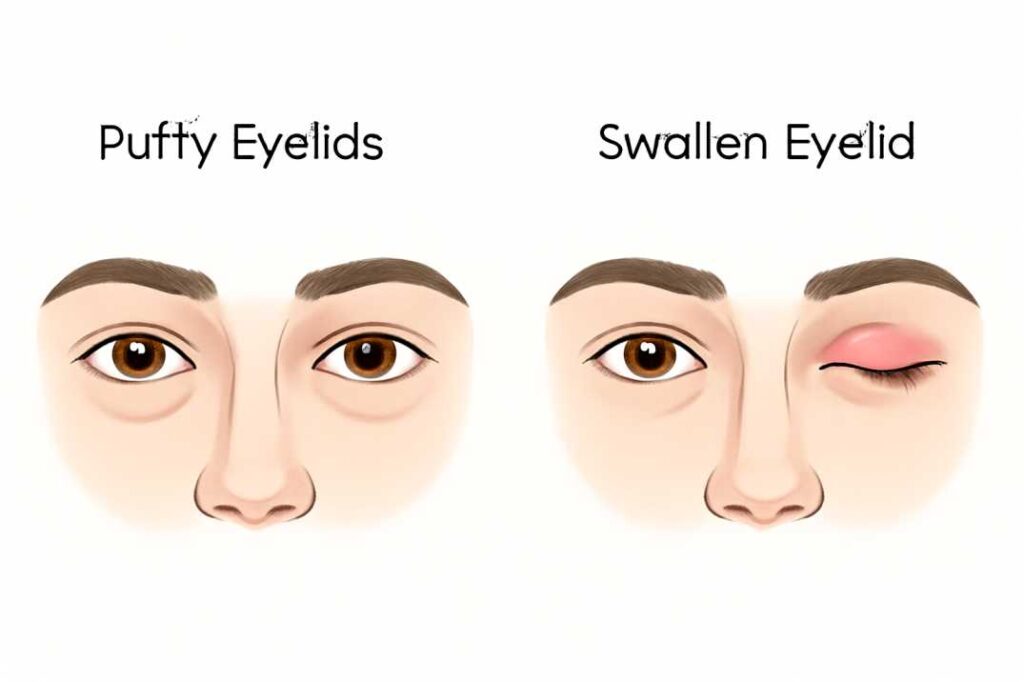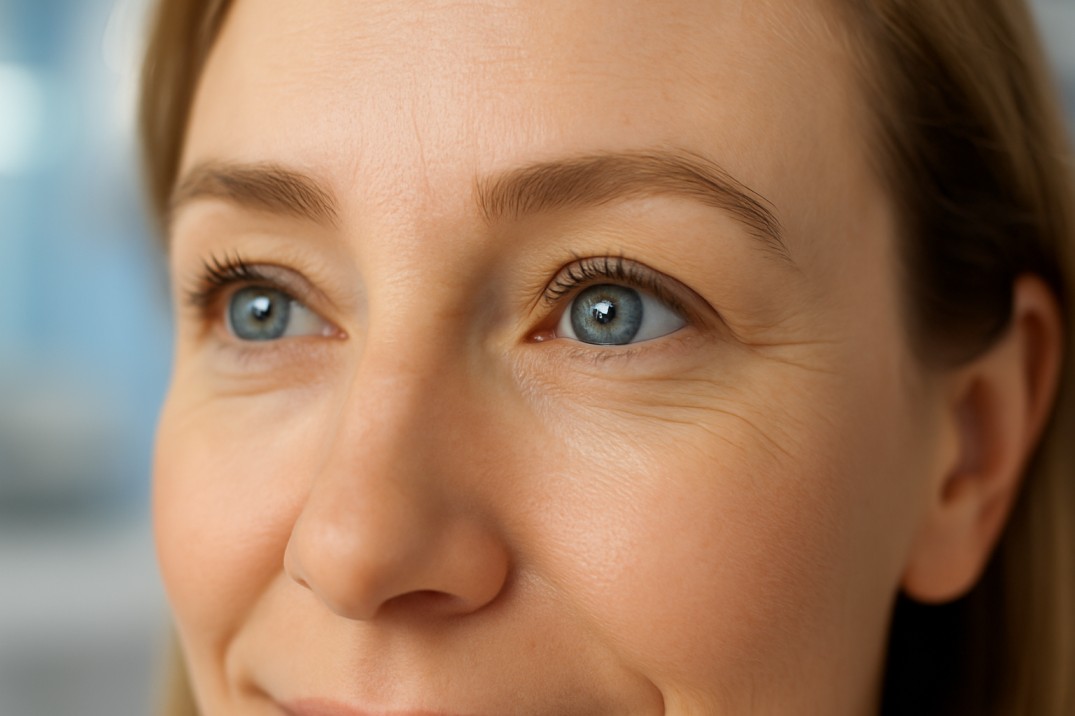All About Swollen Eyelids
Waking up with puffy, swollen eyelids can be alarming and uncomfortable. Whether it’s a sudden onset or a recurring issue, understanding the causes and knowing how to respond can make all the difference in your recovery and peace of mind.
Understanding Swollen Eyelids: A Guide from Cannon EyeCare in Seattle
Swollen eyelids, a condition known to eye doctors as “eyelid edema,” happen when fluid builds up in the delicate tissues surrounding your eye. It’s important to know this is different from under-eye bags, which are often related to genetics or aging. Eyelid swelling is usually a sign of an active issue that needs a professional evaluation.
This swelling can affect different parts of your eye, including:
-
The upper eyelids (most common)
-
The lower eyelids
-
The inner corner (medial canthus)
-
The outer corner (lateral canthus)
Swollen vs. Puffy Eyelids: What’s the Difference?
Many of our Seattle patients at Cannon EyeCare ask how to tell these two apart. Here’s a simple breakdown:
Swollen Eyelids often involve:
-
Pain or tenderness to the touch
-
A feeling of warmth on the eyelid
-
Noticeable redness or inflammation
-
Often starting in one eye
-
Potential vision changes if the swelling is significant
Puffy Eyelids are typically:
-
Painless and not tender
-
Normal skin temperature
-
Shows little to no color change
-
Usually appear on both sides
-
Unlikely to affect your vision
The 8 Most Common Causes of Swollen Eyelids in Seattle
At Cannon EyeCare, we diagnose and treat eyelid swelling every day. Based on our clinical experience with Seattle patients, these are the eight most frequent causes we encounter.
1. Stye (Hordeolum): The Painful Red Bump
A stye is a painful, red bump on the edge of your eyelid caused by a bacterial infection in an eyelash follicle or oil gland.
How to recognize a stye:
-
Sharp, localized pain that increases when you blink
-
A small, pimple-like red bump
-
A yellowish head that may develop after a few days
-
Increased tearing in the affected eye
What to do:
-
Days 1-3: Apply a warm compress for 10-15 minutes, 4-6 times daily.
-
Days 4-7: The stye will usually drain on its own.
-
After 1 week: If it hasn’t improved, schedule an appointment at our Seattle clinic for professional care.
2. Chalazion: The Painless Hard Lump
Often mistaken for a stye, a chalazion is a firm, painless lump caused by a blocked oil gland. We commonly see these in Seattle’s tech professionals due to prolonged screen time.
Key differences from a stye:
-
Typically painless (may have mild tenderness)
-
A firm, well-defined lump under the skin
-
Can grow larger than a stye
-
Can take weeks or even months to resolve
Professional treatment at our Seattle clinic:
-
Conservative warm compress therapy
-
Medicated steroid injections to reduce inflammation
-
Minor surgical drainage for lumps that persist
3. Blepharitis: The Chronic Condition
Blepharitis is a common, persistent inflammation of the eyelids. Proper daily management is key to controlling symptoms, which can be exacerbated by Seattle’s environment.
Two main types:
-
Anterior: Affects the base of your eyelashes.
-
Posterior: Affects the inner eyelid’s oil glands (Meibomian Gland Dysfunction).
Common Seattle triggers:
-
High pollen counts from alder, birch, and cedar trees
-
Dry air from indoor heating during our damp winters
-
Increased screen use without conscious blinking
A daily management routine can help:
-
Morning: Gently clean eyelids with a warm, damp washcloth.
-
Throughout the day: Use preservative-free artificial tears.
-
Evening: Apply a warm compress for 10 minutes to loosen debris.
-
Weekly: Perform a deeper clean with recommended eyelid scrubs.
4. Allergic Reactions: Seattle’s Seasonal Challenge
The Pacific Northwest is beautiful but has distinct allergens that frequently cause puffy, swollen eyelids in our patients.
Common Seattle allergens include:
-
Tree Pollen (Feb-May): Alder, birch, and cedar.
-
Grass Pollen (May-August)
-
Mold Spores (year-round, worse in the damp fall)
-
Indoor Dust Mites (during the heating season)
Signs your swelling is allergy-related:
-
Both eyelids are affected equally
-
Intense itching and watery eyes
-
Symptoms coincide with specific seasons or weather changes
5. Contact Dermatitis: Cosmetic and Environmental Triggers
We treat many patients in our clinic for contact dermatitis, an irritation caused by direct contact with an allergen or irritant.
Common culprits in Seattle:
-
Nickel found in eyelash curlers or tweezers
-
Fragrances and preservatives in eye creams and makeup
-
New laundry detergents or fabric softeners on pillowcases
-
Airborne irritants from local industry or construction
6. Fluid Retention: Understanding Morning Puffiness
Many Seattleites notice worse eyelid puffiness in the morning, especially during periods of high humidity or rain.
Contributing factors include:
-
Sleeping flat on your stomach or without adequate pillow support
-
A diet high in sodium (common with processed foods)
-
Hormonal fluctuations
-
Alcohol consumption or dehydration
For quick morning relief:
-
Sleep with your head slightly elevated.
-
Gently apply a cool compress for 5-10 minutes.
-
Perform a gentle lymphatic massage around the eye area.
-
Drink a large glass of water upon waking.
7. Orbital Cellulitis: A Serious Medical Emergency
This severe infection of the tissues around the eye is rare but requires immediate medical attention. We have successfully treated cases at Cannon EyeCare, and early recognition is vital.
Seek emergency care immediately if you experience:
-
Severe eye pain, especially with movement
-
Sudden vision changes or double vision
-
Fever and chills
-
The eye bulging forward or having limited mobility
If you have these symptoms, go to the nearest emergency room, such as Harborview Medical Center.
8. Graves’ Disease: The Thyroid Connection
This autoimmune disorder can cause thyroid eye disease, leading to characteristic eyelid swelling and a prominent, staring appearance.
Symptoms of thyroid eye disease include:
-
A gradual onset of swelling over weeks or months
-
A persistent feeling of pressure behind the eyes
-
Dry, gritty, and irritated eyes
-
Visible changes in the eye’s appearance
FAQs
-
Most swollen eyelids resolve within 7-10 days with proper treatment. Styes clear in 5-7 days, allergic swelling subsides in 24-48 hours, while chronic blepharitis requires ongoing management.




